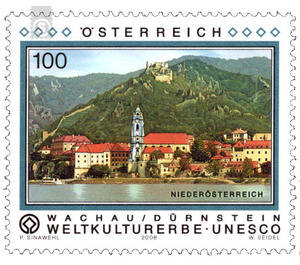UNESCO world heritage - Austria / II. Republic of Austria 2008 - 100 Euro Cent
Theme: Animals
| Country | Austria / II. Republic of Austria |
| Issue Date | 2008 |
| Face Value | 100.00 |
| Edition Issued | 500,000 |
| Printing Type | combination printing |
| Stamp Type | Commemorative |
| Item Type | Stamp |
| Chronological Issue Number | 2061 |
| Chronological Chapter | OOS-OE2 |
| SID | 770861 |
| In 57 Wishlists | |
The Wachau - who does not think in the spring of the apricot blossom that transforms the Danube Valley into a white sea of flowers. In addition to wine, the "Wachauer Qualitätsmarille" is a world-famous product. At the beginning of the apricot festival in April, Austrian Post is highlighting this region, which has been designated a cultural heritage by the UNECO, with a special stamp. The Wachau - which includes the Danube valley from Melk to Krems with the adjacent ridges and the tortuous Kremstal in the north and the Dunkelsteinerwald in the south - is a high-quality habitat and a significant cultural landscape, has hosted for thousands of years people who live in harmony with nature and have merged with it in a special way. The award as a World Cultural Heritage was not wrongly awarded a Gesamtkunstwerk, which is the true Wachau. The meandering river valley, deeply carved into the original rock of the Bohemian mass, impresses with rugged rocks alternating with alluvial forests, on banks and slopes with sun-drenched vineyards and orchards, built and maintained in laborious work. The villages, pens, castles, palaces and ruins bear witness to a long settlement history and cultural tradition that goes back to prehistoric times. The Romans settled since the 1st century BC on the Danube in Favianis, today's Mautern, they brought the cultivation of wine in the Wachau. For 500 years, the Danube formed the northern border of the Roman Empire. In the 5th century, at the time of Saint Severin, the Teutons pushed south. From the time of the migration, the Nibelungenlied tells us about the migration of the Nibelungen through the Wachau to King Etzel in Hunnenland, today's Hungary. In the Middle Ages, the Kuenringer with the castles Dürnstein and Aggstein secured the trade route along the Danube. From the imprisonment of the English King Richard the Lionheart at Dürnstein Castle and his liberation by the singer Blondel tells a well-known legend. Monasteries and churches, outstanding the Melk and Göttweig monasteries at the entrances to the Wachau, formed the centers of faith, knowledge and the economy. Its appeal is unbroken until today. As one of the oldest cultural landscapes in Austria, the Wachau was awarded the Melk and Göttweig Monuments and the Old Town of Krems on 30 November 2000 by the UNESCO Commission in Sydney as a World Heritage Site. "The Wachau is an outstanding example of a river landscape surrounded by mountains, in which material evidence of their long historical development has been preserved to an astounding extent," wrote UNESCO in its explanatory statement.


